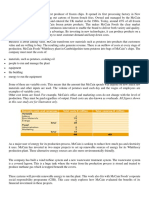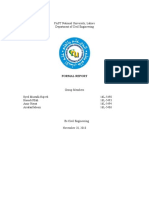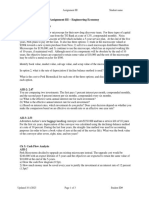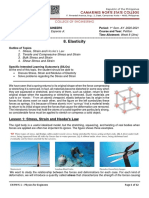Payback BC Method
Payback BC Method
Uploaded by
Jam LarsonCopyright:
Available Formats
Payback BC Method
Payback BC Method
Uploaded by
Jam LarsonOriginal Title
Copyright
Available Formats
Share this document
Did you find this document useful?
Is this content inappropriate?
Copyright:
Available Formats
Payback BC Method
Payback BC Method
Uploaded by
Jam LarsonCopyright:
Available Formats
Republic of the Philippines
CAMARINES NORTE STATE COLLEGE
F. Pimentel Avenue, Brgy. 2, Daet, Camarines Norte – 4600, Philippines
COLLEGE OF ENGINEERING
BES 4 – ENGINEERING ECONOMICS
Activity #5M: Payback Period Method and Benefit-Cost Ratio Method
Name: __________________________________ Course/Yr/Block: __________
Intended Learning Outcome: Apply the concepts of Payback Period Method and Benefit-Cost Ratio
Method on evaluating a proposed projet.
Content/Topics: Payback Period Method and Benefit-Cost Ratio Method
Directions: Solve the following problems on a clean sheet of paper. Show a complete solution and write
legibly. Use ballpens only.
1. A retrofitted space-heating system is being considered for a small office building. The system can be
purchased and installed for $120,000, and it will save an estimated 300,000 kilowatt-hours (kWh) of
electric power each year over a six-year period. Akilowatt-hour of electricity costs $0.10, and the company
uses a MARR of 15% per year in its economic evaluations of refurbished systems. The market value of
the system will be $8,000 at the end of six years, and additional annual operating and maintenance
expenses are negligible. Use the benefit–cost method to make a recommendation.
2. A proposal has been made for improving the downtown area of a small town. The plan calls for banning
vehicular traffic on the main street and turning this street into a pedestrian mall with tree plantings and
other beautification features. This plan will involve actual costs of $6,000,000 and, according to its
proponents, the plan will produce benefits and disbenefits to the town as follows:
Benefits:
Increased sales tax revenue $450,000 per year
Increased real estate property taxes $325,000 per year
Benefits due to decreased air pollution $80,000 per year
Quality of life improvements to users $70,000 per year
Disbenefits:
Increased maintenance $175,000 per year
a. Compute the B–C ratio of this plan based on a MARR of 10% per year and an infinite life for the project.
b. How does the B–C ratio change for a 20-year project life?
3. A 2,000 square foot house in New Jersey costs $1,725 each winter to heat with its existing oil-burning
furnace. For an investment of $5,000, a natural gas furnace can be installed, and the winter heating bill is
estimated to be $1,000. If the homeowner’s MARR is 6% per year, what is the discounted payback period
of this proposed investment?
4. A solar sea power plant (SSPP) is being considered in a North American location known for its high
temperature ocean surface and its much lower ocean temperature 100 meters below the surface. Power can
be produced based on this temperature differential. With high costs of fossil fuels, this particular SSPP
may be economically attractive to investors. For an initial investment of $100 million, annual net revenues
are estimated to be $15 million in years 1–5 and $20 million in years 6–20. Assume no residual market
value for the SSPP.
a. What is the simple payback period for the SSPP?
b. What is the discounted payback period when the MARR is 6% per year?
c. Would you recommend investing in this project?
BES 4 – Engineering Economics Page 1 of 1
You might also like
- Sample BillDocument3 pagesSample BillKilimani T.VNo ratings yet
- Cost and Benefit Analysis of Solar Panels at HomeDocument8 pagesCost and Benefit Analysis of Solar Panels at HomePoonam KilaniyaNo ratings yet
- October 20, 2022 Account Number: 100 146 720 485 Amount Due: $49.14 Due Date: November 09, 2022Document2 pagesOctober 20, 2022 Account Number: 100 146 720 485 Amount Due: $49.14 Due Date: November 09, 2022Carlos Andres Barrera CastillaNo ratings yet
- Test 14Document7 pagesTest 14Zoloft Zithromax ProzacNo ratings yet
- Solar Lanterns Concept NoteDocument3 pagesSolar Lanterns Concept NoteSatish Shukla100% (2)
- 6 Comparing AlternativesDocument49 pages6 Comparing AlternativesTrimar DagandanNo ratings yet
- Energuide Label InfographicDocument1 pageEnerguide Label InfographiclindaNo ratings yet
- A3f Ee 21Document2 pagesA3f Ee 21shuckss taloNo ratings yet
- BIG SFA Summary Program Cover PageDocument4 pagesBIG SFA Summary Program Cover PageLauren WatsonNo ratings yet
- 6.15.12 Pressrelease 9proposalsDocument2 pages6.15.12 Pressrelease 9proposalsAnonymous Feglbx5No ratings yet
- EM Final Paper Assingment EE GCU S18Document4 pagesEM Final Paper Assingment EE GCU S18KhanNo ratings yet
- Chapter 05 Problems & Final AnswersDocument3 pagesChapter 05 Problems & Final AnswersMostafa FouadNo ratings yet
- Eceecon Problem Set 2Document8 pagesEceecon Problem Set 2Jervin JamillaNo ratings yet
- ENGR301 Exam Practice Questions2 Winter 2013Document1 pageENGR301 Exam Practice Questions2 Winter 2013Jonathan RuizNo ratings yet
- Bond Recommendation PresentationDocument24 pagesBond Recommendation PresentationJim ParkerNo ratings yet
- PS Es301Document2 pagesPS Es301Rosel Marvie CareNo ratings yet
- Finals Sa1: Depreciation and Depletion: MC TheoryDocument8 pagesFinals Sa1: Depreciation and Depletion: MC TheoryShaina NavaNo ratings yet
- F5 Past ExamsDocument30 pagesF5 Past ExamsBread crumbNo ratings yet
- EEE Assignment 1Document7 pagesEEE Assignment 1kong yiNo ratings yet
- Project Plan 34552068Document4 pagesProject Plan 34552068aqsaNo ratings yet
- John Vincent Hvac ReportDocument10 pagesJohn Vincent Hvac Reportjethro ganeloNo ratings yet
- Alt Energy Policy Update - Stimulus Package - 2009 1 15Document7 pagesAlt Energy Policy Update - Stimulus Package - 2009 1 15Emilio MeraNo ratings yet
- The Status of The Uk Domestic PV Market - A Review of The Impact of The Low Carbon Buildings ProgrammeDocument4 pagesThe Status of The Uk Domestic PV Market - A Review of The Impact of The Low Carbon Buildings ProgrammeMohammed FarhanNo ratings yet
- Rural Electrification: Solar in Mindanao - A Social Business ModelDocument17 pagesRural Electrification: Solar in Mindanao - A Social Business ModelStefano VrespaNo ratings yet
- Dw-11 Administration Answer KeyDocument9 pagesDw-11 Administration Answer KeyRam CaceresNo ratings yet
- ENG007 Engineering Economics: Assignment #2Document4 pagesENG007 Engineering Economics: Assignment #2MichaelCharryPonceNo ratings yet
- Assignments Eco PDFDocument7 pagesAssignments Eco PDFKaman LuitelNo ratings yet
- Power Plant Module 1 For FINALS PDFDocument8 pagesPower Plant Module 1 For FINALS PDFRex Sotelo BaltazarNo ratings yet
- Macroeconomics Fourteenth Canadian Edition Canadian 14th Edition Ragan Solutions ManualDocument11 pagesMacroeconomics Fourteenth Canadian Edition Canadian 14th Edition Ragan Solutions Manualadelaideoanhnqr1v100% (31)
- Socio Eco Final Exam Part 2Document8 pagesSocio Eco Final Exam Part 2mdevmg1yNo ratings yet
- 2nd Assignment 2021Document3 pages2nd Assignment 2021No NameNo ratings yet
- Cold StoresDocument24 pagesCold StoresPRKrauseNo ratings yet
- FPL Proposal For A Florida Renewable Portfolio Standard: FPSC Staff Workshop December 6, 2007Document16 pagesFPL Proposal For A Florida Renewable Portfolio Standard: FPSC Staff Workshop December 6, 2007Daniel Jesus Hernandez BallenaNo ratings yet
- Engineering EconomicsDocument17 pagesEngineering EconomicsIan BondocNo ratings yet
- Make A Power Point Presentation On Economics of R... - 1Document4 pagesMake A Power Point Presentation On Economics of R... - 1sse.nagpur1No ratings yet
- 2022 - 10 - 14 - MG Design Case StudyDocument5 pages2022 - 10 - 14 - MG Design Case StudyKnch Lhnn CabilloNo ratings yet
- BBCDPR Business Plan (DRAFT)Document7 pagesBBCDPR Business Plan (DRAFT)John Emmanuel PacresNo ratings yet
- Policy Brief 01 Economic Impact of Higher Share of Solar PhotovoltaicDocument19 pagesPolicy Brief 01 Economic Impact of Higher Share of Solar PhotovoltaicEverything iKnowNo ratings yet
- Economics Tutorial-Sheet-2Document3 pagesEconomics Tutorial-Sheet-2Saburo SahibNo ratings yet
- Mgerken Eblf Presentation 2009Document28 pagesMgerken Eblf Presentation 2009suetierneyNo ratings yet
- Implementation PhaseDocument4 pagesImplementation PhaseFmuharIrolNo ratings yet
- Wildcatting The SunDocument4 pagesWildcatting The SunAndy WilsonNo ratings yet
- 380Document2 pages380Venkat100% (1)
- US Energy ProgramsDocument134 pagesUS Energy ProgramsEd ChikuniNo ratings yet
- Aaay1 All Chapr Assignments2016 MitDocument4 pagesAaay1 All Chapr Assignments2016 MitSenay MehariNo ratings yet
- Solar ProjectDocument7 pagesSolar ProjectPriyanka MishraNo ratings yet
- Sheet 2 Engineering EconomyDocument3 pagesSheet 2 Engineering Economywasem.1048No ratings yet
- Applied Science University: Faculty of Engineering Mechanical and Industrial EngineeringDocument6 pagesApplied Science University: Faculty of Engineering Mechanical and Industrial EngineeringMahmoud AlswaitiNo ratings yet
- Tut 5Document2 pagesTut 5Rao BilalNo ratings yet
- BIE Exam 9 September 2021 TextDocument8 pagesBIE Exam 9 September 2021 TextomerogolddNo ratings yet
- Cost Management Additional ProblemsDocument2 pagesCost Management Additional ProblemsJerremae C GarciaNo ratings yet
- MC CainDocument6 pagesMC CainDivyesh Gandhi100% (1)
- FAST National University, Lahore Department of Civil EngineeringDocument12 pagesFAST National University, Lahore Department of Civil EngineeringSyed Mustafa NajeebNo ratings yet
- 3P04 A3 2023-EconDocument3 pages3P04 A3 2023-EconArisa TieuNo ratings yet
- A Consumer Bill of Rights For Energy ConservationDocument6 pagesA Consumer Bill of Rights For Energy Conservationsteven florezNo ratings yet
- Money-Time Relationships and Equivalence: Camarines Norte State CollegeDocument6 pagesMoney-Time Relationships and Equivalence: Camarines Norte State CollegeSarah Jean M. AlvisNo ratings yet
- Multifamily HousingDocument12 pagesMultifamily HousingBhaskar DeNo ratings yet
- Applied Science University: Faculty of Engineering Mechanical and Industrial EngineeringDocument4 pagesApplied Science University: Faculty of Engineering Mechanical and Industrial EngineeringMahmoud AlswaitiNo ratings yet
- Shedding Light On Solar PV and Incentives: Natalie Andrews Renewable Energy Program CoordinatorDocument39 pagesShedding Light On Solar PV and Incentives: Natalie Andrews Renewable Energy Program CoordinatorLogesh KumarNo ratings yet
- Rebuilding America 2016: Macroeconomic Effects of Large Scale Climate Mitigation ProgramDocument5 pagesRebuilding America 2016: Macroeconomic Effects of Large Scale Climate Mitigation ProgramDarrell PrinceNo ratings yet
- Depreciation ExerciseDocument11 pagesDepreciation Exerciserikita_17100% (2)
- Madeleine Varkay - Developing EE Finance For IndonesiaDocument12 pagesMadeleine Varkay - Developing EE Finance For IndonesiaAsia Clean Energy ForumNo ratings yet
- Art Apreciation Sample QuestionsDocument2 pagesArt Apreciation Sample QuestionsJam LarsonNo ratings yet
- 22-364 Plans 2Document9 pages22-364 Plans 2Jam LarsonNo ratings yet
- Local Media1584958993263444966 PDFDocument6 pagesLocal Media1584958993263444966 PDFJam LarsonNo ratings yet
- 08 ElasticityDocument12 pages08 ElasticityJam LarsonNo ratings yet
- Chapter 4 Plumbing FixturesDocument44 pagesChapter 4 Plumbing FixturesJam LarsonNo ratings yet
- 06 Work, Energy, and PowerDocument11 pages06 Work, Energy, and PowerJam LarsonNo ratings yet
- Energy and Chemistry: Lesson 1: Nature of EnergyDocument13 pagesEnergy and Chemistry: Lesson 1: Nature of EnergyJam LarsonNo ratings yet
- Properties of Laplace TransformsDocument8 pagesProperties of Laplace TransformsJam LarsonNo ratings yet
- Learning Module No. 1Document14 pagesLearning Module No. 1Jam LarsonNo ratings yet
- Philosophy of SexualityDocument22 pagesPhilosophy of SexualityJam LarsonNo ratings yet
- Laro NG LahiDocument8 pagesLaro NG LahiJam LarsonNo ratings yet
- Introduction To Civil AffairsDocument35 pagesIntroduction To Civil AffairsJam LarsonNo ratings yet
- Functions of Management Functions of Management: LeadingDocument26 pagesFunctions of Management Functions of Management: LeadingJam LarsonNo ratings yet
- Controlling: Functions of ManagementDocument21 pagesControlling: Functions of ManagementJam LarsonNo ratings yet
- Managing Production and Service OperationsDocument22 pagesManaging Production and Service OperationsJam LarsonNo ratings yet
- Electrical and Electronic Measurements and InstrumentationDocument23 pagesElectrical and Electronic Measurements and InstrumentationKarthik VNo ratings yet
- Sample DPR For Hydro Project 10 MW 2012Document177 pagesSample DPR For Hydro Project 10 MW 2012Premnath YadavNo ratings yet
- 20 05 13 FEV High Performance Battery For Premium Class Hybrid VehiclesDocument16 pages20 05 13 FEV High Performance Battery For Premium Class Hybrid VehiclesProvocateur SamaraNo ratings yet
- Crompton-Fans-Energion GroveDocument1 pageCrompton-Fans-Energion GroveTaher SiamwalaNo ratings yet
- Title - Project Proposal On Edible Oil PRDocument28 pagesTitle - Project Proposal On Edible Oil PRSurafel Abate100% (1)
- Energy-Efficient Electric Motors and Their Applications by Howard E. Jordan (Auth.)Document194 pagesEnergy-Efficient Electric Motors and Their Applications by Howard E. Jordan (Auth.)mylaptop VJethoseNo ratings yet
- 100 TPD ROSA Projection at 25 Deg CDocument5 pages100 TPD ROSA Projection at 25 Deg Cjugal ranaNo ratings yet
- Erg ErgfeDocument2 pagesErg Ergfeghrasel30No ratings yet
- Dissertation Saurabh Barange 500074689 Power ManagementDocument37 pagesDissertation Saurabh Barange 500074689 Power ManagementAvishek GhosalNo ratings yet
- PPT-16, Subject-Physics, Class - 11, Work, Energy and PowerDocument8 pagesPPT-16, Subject-Physics, Class - 11, Work, Energy and PowerShoryamann SharmaNo ratings yet
- Growatt ManualDocument28 pagesGrowatt ManualDenis Carneiro SantosNo ratings yet
- Objective Electrical EngineeringDocument4 pagesObjective Electrical Engineeringdinesh majumdarNo ratings yet
- ETM Microproject ReportDocument12 pagesETM Microproject ReportkadolesamarthNo ratings yet
- Somalia ESRES Complementary Studies FinalDocument79 pagesSomalia ESRES Complementary Studies Finalzaheer ahamedNo ratings yet
- Math 6Document6 pagesMath 6Edward Joseph CelarioNo ratings yet
- Renewable Energy - Solar Financial Modeling Course PresentationDocument45 pagesRenewable Energy - Solar Financial Modeling Course PresentationJuan Diego ForeroNo ratings yet
- Chapter 4. HydropowerDocument88 pagesChapter 4. HydropowerThien Le Nhut HongNo ratings yet
- Problems For Algorithm DevelopmentDocument3 pagesProblems For Algorithm DevelopmentNathaniel CorderoNo ratings yet
- Electricity - Grade 9Document9 pagesElectricity - Grade 9nidda beeNo ratings yet
- OUCCS Mock ExamDocument16 pagesOUCCS Mock ExamCarlitos Harvey Calibo HipolitoNo ratings yet
- Lista 1 - Corrente ContínuaDocument5 pagesLista 1 - Corrente ContínuaVilson ConradoNo ratings yet
- Reed A. Off Grid Solar Power Handbook - 12 Volts Mobile Solar Power For RVS, Boats, Vans, Campers, Cabins and Tiny Homes, 2020Document161 pagesReed A. Off Grid Solar Power Handbook - 12 Volts Mobile Solar Power For RVS, Boats, Vans, Campers, Cabins and Tiny Homes, 2020VitBar50% (2)
- EEE547 IntroductionDocument43 pagesEEE547 IntroductionprixxzyNo ratings yet
- Efficiency Worksheet (ANS)Document3 pagesEfficiency Worksheet (ANS)Leeda849No ratings yet
- Power Meter Cost InstructionsDocument2 pagesPower Meter Cost Instructionsjohnamer90No ratings yet
- BioTherm Energy (Pty) Ltd. Was Acquired by Actis LLP - MergermarketDocument8 pagesBioTherm Energy (Pty) Ltd. Was Acquired by Actis LLP - MergermarketrivaltzNo ratings yet
- Descriptive Statistics ProjectDocument11 pagesDescriptive Statistics ProjectValdemar MacananoNo ratings yet








































































































